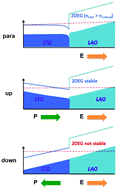Tunability of the two-dimensional electron gas at the LaAlO3/SrTiO3 interface by strain-induced ferroelectricity†
Abstract
The two-dimensional electron gas (2DEG) formed at the interface between two insulating materials LaAlO3 (LAO) and SrTiO3 (STO) has recently generated a lot of interest. Here, based on first-principles density functional theory calculations, we investigate the existence and stability of the 2DEG under the application of a biaxial strain on the LAO/STO(001) heterostructure. The compressive strain induces ferroelectric (FE) polarization in STO, which allows for the tunability of the 2DEG by reversing the STO polarization orientation. We show that the formation of the 2DEG is unstable when LAO and STO have the same polarization direction. On the other hand, the 2DEG will always form if the two polarizations are in the opposite directions regardless of the LAO thickness, which is in contrast to the unstrained interface that has a critical thickness for stabilizing the 2DEG. We show that the underpinnings of this behavior are due to charge passivation and band gap alignment.


 Please wait while we load your content...
Please wait while we load your content...